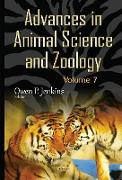Advances in Animal Science & Zoology
BücherAngebote / Angebote:
This book focuses on recent advances in animal science and zoology research. In the first chapter, animal science is introduced along with major hurdles related to animal agriculture and then proposes a solution for these grand challenges on a global scale. In the second chapter, the author focuses on canine leptospirosis, a zoonotic disease of worldwide distribution, which affects both humans and animals with humans being an accidental host. The third chapter assesses the outcomes of current research and future directions for improving post-thaw viability of stallion sperm (since the first success of mammalian cell cryopreservation, it has become a major method of cell preservation for both human and veterinary medicine). The fourth chapter focuses on the evaluation of all main hematological, biochemical, and coproparasitologic changes, besides larval designation found within pastures of Dorper breed sheeps and females through peripartum. In the fifth chapter, in the search for new food sources that contribute to the optimisation of livestock production, the authors discuss the possibility of using waste from a marine plant commonly found on the Mediterranean coasts. The next two chapters focus on penguin physiology, behavior as well as the identification of viruses capable of infecting both free-living healthy penguins, and the pathogens that may be related to the release of rehabilitated penguins and the implication of these agents in the conservation of the species. The remaining chapters of this book review current knowledge on the intra and inter-species behavior of Turkey vultures, molecular mechanisms operating in the Xenopus osmoregulatory organs and the physiological role of AQPs in Xenopus, and the impact of extended drought on the reproductive cycle of an endangered tropical killifish in the Brazilian semiarid region. The last chapter is a commentary on the the use of field sampling techniques and computerised video tracking in the study of directional grasshopper movement, influenced by climatic stimuli such as temperature, light, wind direction and habitat factors.
Folgt in ca. 15 Arbeitstagen




